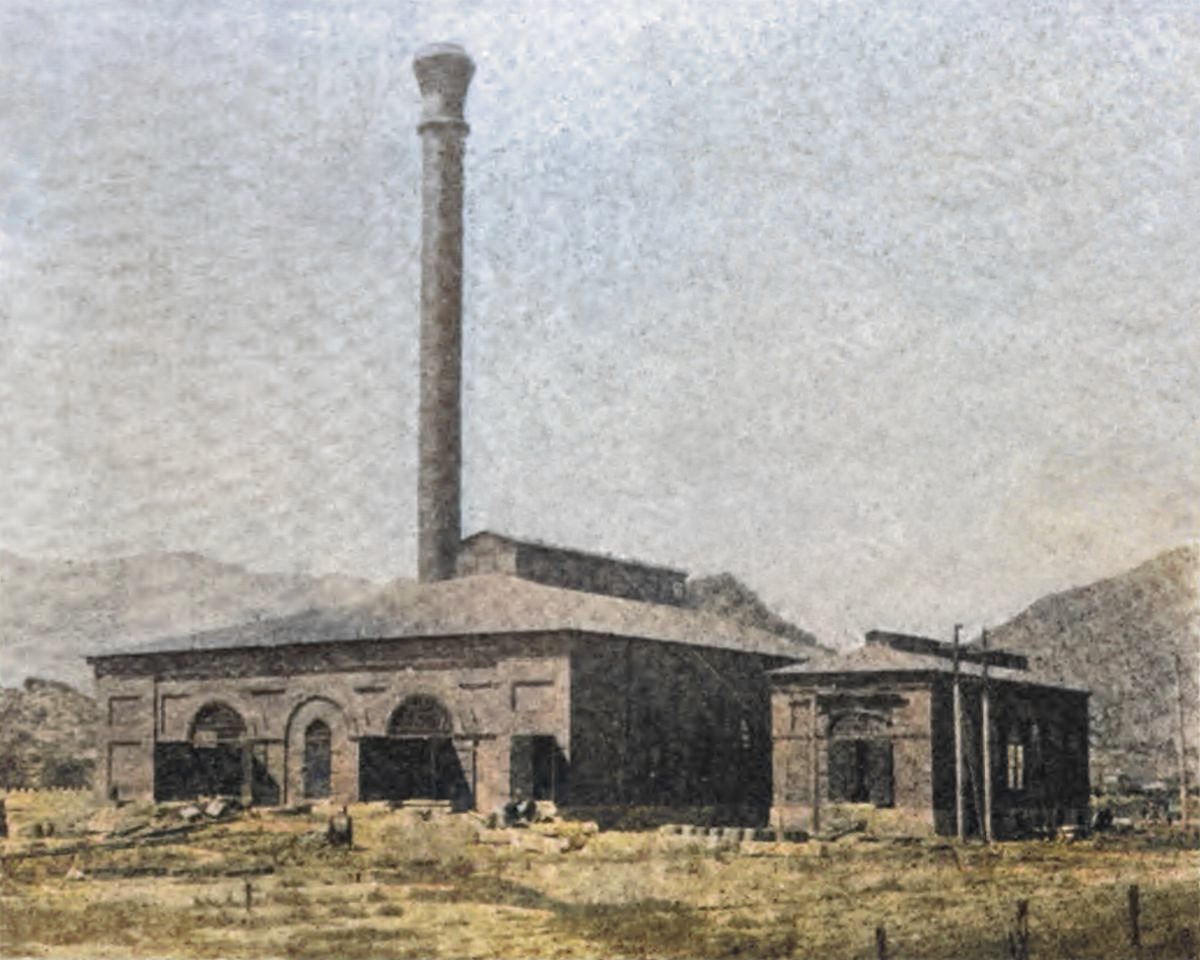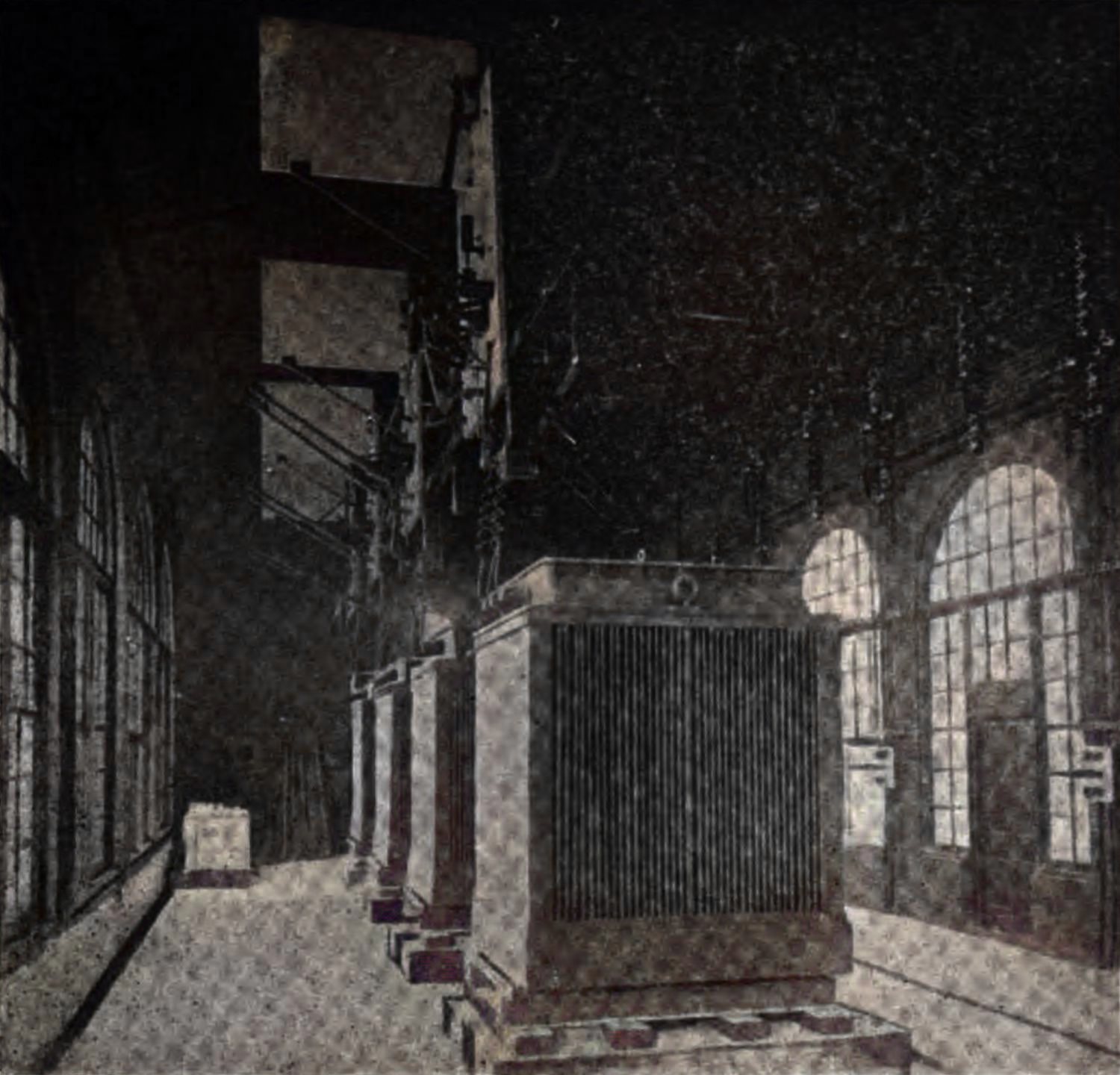-> HathiTrust Digital Library Site; Link to First page of article.
I procured the coloring of the images.
ON the morning of August 16 a party of 400, including mine owners and electricians, gathered at the Denver & Rio Grande station, at Colorado Springs, to take the train for Canon City, being accompanied by the Midland Band. This excursion was given by D. V. Donaldson, president of the Colorado Electric Power Co., for the purpose of showing the mine owners that they could be supplied with power and light, from a station, at a distance of twenty-four miles from their mines.
The special train took on a number of prominent mining men at Pueblo, arriving at the power house at Canon City at 11:30 a. m. Exactly at noon Gov. Adams stepped forward to the switchboard in the generator room and pulled down a lever which set the machinery in motion.
Already $250,000 has been expended upon this plant, and half as much again will be put out before the equipment is complete, in the Cripple Creek end of the line. The plant is a model of its kind, and is without an equal in point of completeness in this country.
The Colorado Electric Power Co.'s plant is located in a substantial structure, 140 by 106 feet, built of stone, brick and steel, and is, consequently, fireproof. The west end of the building is put in temporarily, so that the plant may be extended at any time.
In this building are the boilers, three immense Hamilton Corliss engines, with three large Westinghouse alternating current generators, adapted for operating the Tesla three-phase system, which is the system of transmission used. Each machine has its armature mounted on the shaft of a Hamilton-Corliss compound-condensing engine, and the combination of engine and dynamo forms a generating unit.
There are three of these units at present, one of which will always be kept idle as a reserve in case of emergency.
For exciting fields for the main dynamos there is a "Kodak" exciter outfit which is capable of exciting all three of the main dynamos. A rotary transformer is ordinarily used for exciting, the Kodak being a reserve. The engines are all supplied from a battery of Heine water tube boilers, and the exhaust steam from the engines driving the main dynamos is taken care of in a surface condenser.
The air and circulating pumps and feed pumps are all of the Snow make. The electric and steam machinery is capable of supplying 2,000 h. p.
From the main dynamos the current is taken to the switch board, hence it is distributed to the raising transformers, of which there are four, three in service and one reserve. Here the current is transformed from the 500 volts delivered by the dynamos to 20,000 volts, at which pressure it is delivered to the transmission line.
The first distributing station is near Victor, on the saddle between Battle Mountain and Bull Hill. The location of the second sub-station is on the saddle between Globe Hill and Gold Hill, near Cripple Creek. At the sub-station the current is again transformed, but this time from 20,000 volts back to 500 volts, at which pressure it is delivered to the mines for all uses, both light and power.
One of the principal points kept in view in the construction of this plant is that of insuring continuous service. The machinery and construction are the very best, and reserve capacity is carried throughout.
The construction of the transmission line is most substantial; particular pains have been taken to protect it from lightning troubles. In addition to the lightning arresters in the generating station at Canon City and in the sub-stations lightning arresters have been installed at a number of points along the transmission line.
It should be added that, in addition to the twenty-five miles between Canon City and Cripple Creek there is about six miles of line over the camp, which will make the total length of line thirty miles. It took nearly twelve months to complete the plant ready for work.
The entire line is patrolled by experienced linemen, who are literally walking telephones. They carry with them little telephones, which they can connect with the line at any point and send in word wherever they find a break.
Western Union call boxes are stationed along the line, and through them the patrolman must send in a signal where he is every hour. These calls are registered at the stations at each end of the line.
It has been carefully computed that there will be a saving of 25 per cent. in the running expenses of the mines if electricity is used, in so far as the matter of hoisting the ore, running drills and doing whatever steam can do is concerned.
Then, again, there can be no argument brought against the convenience. Will there be no breakdowns? The experiences of the plant of the Central California Power Co., at Sacramento, are typical in this regard. In that instance during the two years that the plant has been in operation there have been but three stops, two for five minutes and one for twenty minutes; in all, thirty minutes.
There is one phase of the question that is to be remarked upon by the bringing of electricity into the camps of many of the smaller properties now being worked by horses. These will now be furnished with a cheap motive power that will render the use of horse power dear in comparison; that is, when the amount of work that can be accomplished with the new power is considered.
This is bound to result in the developing of many small properties that have been worked indifferently heretofore. Power will be rented out to these prospectors at definite schedules, so that each one knows before he starts just how much it will cost him for his month's work. If at the end of the month he finds that it does not pay, then the little motor can be taken out and operations transferred to another locality.
But, with the large mines, all that need be said is that everything that is being done now with steam will be done hereafter by electricity. Among the mines that will supplant steam with the new power are
the Lillie
the Taylor and Brunton Sampler
the Wisconsin group, owned by the Morses
the Jack Pot
the Work
the Mary Anne
the Moon-Anchor and others.
The Portland, the Hull City placer mine and other large properties are figuring on power, and as soon as favorable terms can be negotiated steam will be abandoned in these mines and electricity substituted.
The building was erected by Canon City constructors. The boilers, engines, pumps, etc., are by Stearn & Rogers, of Denver; all electrical machinery was furnished by the Westinghouse Company, and the pole line by the Mountain Electric Company, of Denver.
| Name | Officer Role | Other Role |
|---|---|---|
| D. V. Donaldson, of Colorado Springs | President and General Manager | Director |
| J. R. McKinney | Vice-President | |
| J. R. McKinnie, of Colorado Springs | Director | |
| Walter Scott, of Colorado Springs | Secretary | Director |
| J. A. Hayes, of Colorado Springs | Treasurer | Director |
| R. H. Sterling | Superintendent | |
| R. D. Mershon | Chief Engineer | |
| H. G. Lunt, of Colorado Springs | Director | |
| John G. Holmes, of Pittsburg | Director | |
| J. G. White, of New York City. | Director |



